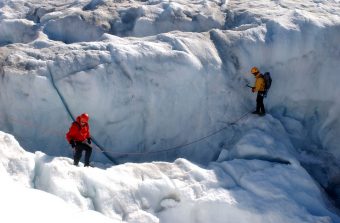The frozen extremities of the northern hemisphere are melting at a near-record rate as heatwaves buffet the Arctic, forest fires tear through Siberia and glaciers retreat on Greenland fjords and Alpine peaks.

Unusually high temperatures are eating into ice sheets that used to be solid throughout the year, according to glaciologists, who warn this is both an amplifying cause and effect of man-made climate disruption across the globe.
Greenland – which is home to the world’s second biggest ice sheet – is likely to have shrunk more in the past month than the average for a whole year between 2002 and now. Surface ice declined in July by 197 gigatonnes, equivalent to about 80m Olympic swimming pools, according to Ruth Mottram of the Danish Meteorological Institute. An additional third of that amount is likely to have been lost from glaciers and icebergs.
The trend is accelerating. Wednesday was by far the biggest single-day melt-off of the year.
With more than a month of the melt season to go, 2019 is already one of the top 10 years for ice loss in Greenland. The extent is thought unlikely to beat the record in 2012, but Luke Trusel, an assistant professor of geography at Penn State university, said the strength of the melt was greater.
Temperatures have been 10C or more above normal this week. Even at the summit of the ice sheet – which is 3,200 metres above sea level – there were 10 hours at or above freezing temperatures yesterday, which is extremely rare, he said. More broadly, ice core analysis has shown that the runoff is at levels expected only once every century, possibly even every millennium.
“What was highly unusual in the recent past is becoming the new normal. The Arctic is far more sensitive to warming now than even a few decades ago,” Trusel said.
The impact on sea level has not yet been calculated, but the high temperatures are likely to accelerate the calving of the giant Petermann glacier, where at least two huge cracks have been identified in recent years. Giant chunks of ice – each several kilometres in length – are expected to collapse into the ocean in the next few years.
The Russian government has belatedly declared a state of emergency in four Siberian regions and reportedly sent troops to help extinguish forest fires that have ripped across an area the size of Belgium.
This follows record-high temperatures in several locations.
In the Canadian Arctic, which is warming two times faster than the global average, locals have suffered record wildfires, and permafrost is melting decades ahead of predictions.
European mountains have been affected too. Authorities have warned that the slopes below the Matterhorn’s 4,480-metre peak are increasingly prone to avalanches and landslides because the ice-core is warming. High-altitude lakes of meltwater have also been reported in the Mont Blanc mountain range in France.
In Switzerland, the threat to alpine glaciers has been so alarming that more regions are using giant fleece blankets to try to insulate the ice from the hot air.
Read more: Guardian

